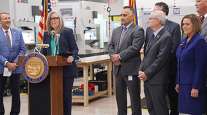Staff Reporter
Illinois Offering Written CDL Tests in Spanish

[Stay on top of transportation news: Get TTNews in your inbox.]
After a recent move in Maryland, Illinois is the latest state to offer commercial driver license applicants a written test in Spanish to get more drivers on the road.
Illinois Secretary of State Alexi Giannoulias announced that state residents applying for their CDL now have a Spanish study guide and can take the written CDL test in Spanish.
“This change will help qualified individuals whose primary language is Spanish to become licensed drivers and will help us address school bus and truck driver shortages across the state while maintaining stringent testing standards,” Giannoulias said. “Offering the CDL test in Spanish is one of the many steps our office is taking to ensure our services are as accessible and inclusive as possible.”
This new inclusion of Spanish-language materials into CDL testing is meant not only to help offset the state’s driver shortage, but to increase the number of school bus drivers and drivers for agricultural producers who rely on temporary workers.
To help reverse truck and bus driver shortages and to increase access to the job, the written Commercial Driver’s License (CDL) test can now be taken in Spanish, Secretary of State Alexi Giannoulias announced Monday.https://t.co/u7FlzjWNY0 — WCIA (@WCIA3) July 9, 2024
Testing standards, the written test and CDL requirements remain unchanged by the translation, but having the materials in Spanish makes it easier for people to understand the detailed technical information included on the test if English is their second language.
“Applicants must still complete their road test and pre-trip inspection in English as applicants must understand basic verbal instructions to comply with federal guidelines from the Federal Motor Carrier Safety Administration,” according to the Illinois secretary of state’s office. “All CDL applicants must have U.S. citizenship, legal permanent residency status or be a nondomiciled driver.”
Illinois Farm Bureau President Brian Duncan remarked earlier this year: “From locating qualified truck drivers to haul grain, to sourcing enough hands to pick vegetables or manage livestock, the shortage of links in the transportation and agricultural supply chains continues to undermine food access and threaten the financial health of farms in Illinois and nationwide.”
Jeff Loftus of FMCSA joins TT’s Seth Clevenger to discuss the current outlook on ADAS technology and how it will affect the industry at large. Tune in above or by going to RoadSigns.ttnews.com.
As of July 2024, there were 378,500 drivers with valid CDLs in Illinois. Meanwhile, Maryland joined over 20 states such as Virginia, Texas and Pennsylvania when it began offering CDL testing in Spanish in May.
The Maryland Motor Vehicle Administration (MVA) is offering its CDL knowledge test in Spanish “to be more inclusive, accessible and convenient for Maryland’s diverse population,” state Transportation Secretary Paul Wiedefeld noted. As of May, there were 114,000 valid CDLs in Maryland.
In accordance with FMCSA guidelines, Maryland is administering a Spanish-language knowledge test without an interpreter, while the skills test and pre-trip inspection continue to be administered in English since applicants must be able to understand and respond to verbal instructions by an examiner.
Want more news? Listen to today's daily briefing above or go here for more info
“We recognize that individuals may feel more comfortable reading in their native language, especially when those materials include technical information,” Motor Vehicle Administrator Christine Nizer explained May 20. Offering the CDL knowledge test in Spanish removes potential barriers to obtaining a CDL which supports the critical needs in moving goods throughout Maryland and our country and enhancing safety on our roadways.”
The new options came about after Maryland state Del. Deni Taveras approached MVA earlier this year to inquire about offering the CDL knowledge test in Spanish. Then MVA began working with its software vendor, which confirmed that Spanish could be added and began the implementation process.
“In Prince George’s County and across Maryland, we must address the income disparity where new Americans earn $17,000 less than the average U.S.-born citizen. This wage gap is evident not only in Prince George’s County but also statewide. We need to bridge this divide,” Taveras remarked. “Individuals with CDL licenses are more likely to be making a living wage for themselves and for their families. We also have a shortage of school bus drivers, and this industry is always in need of new drivers. Therefore, these licenses will address this transportation need as well.”





